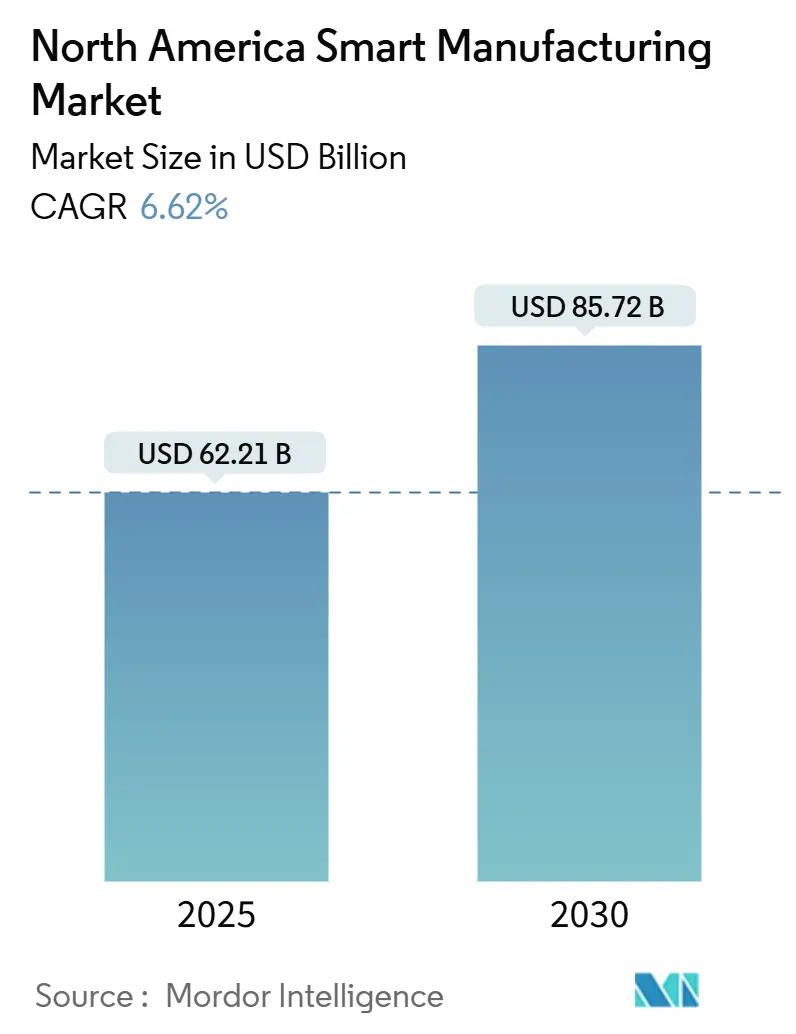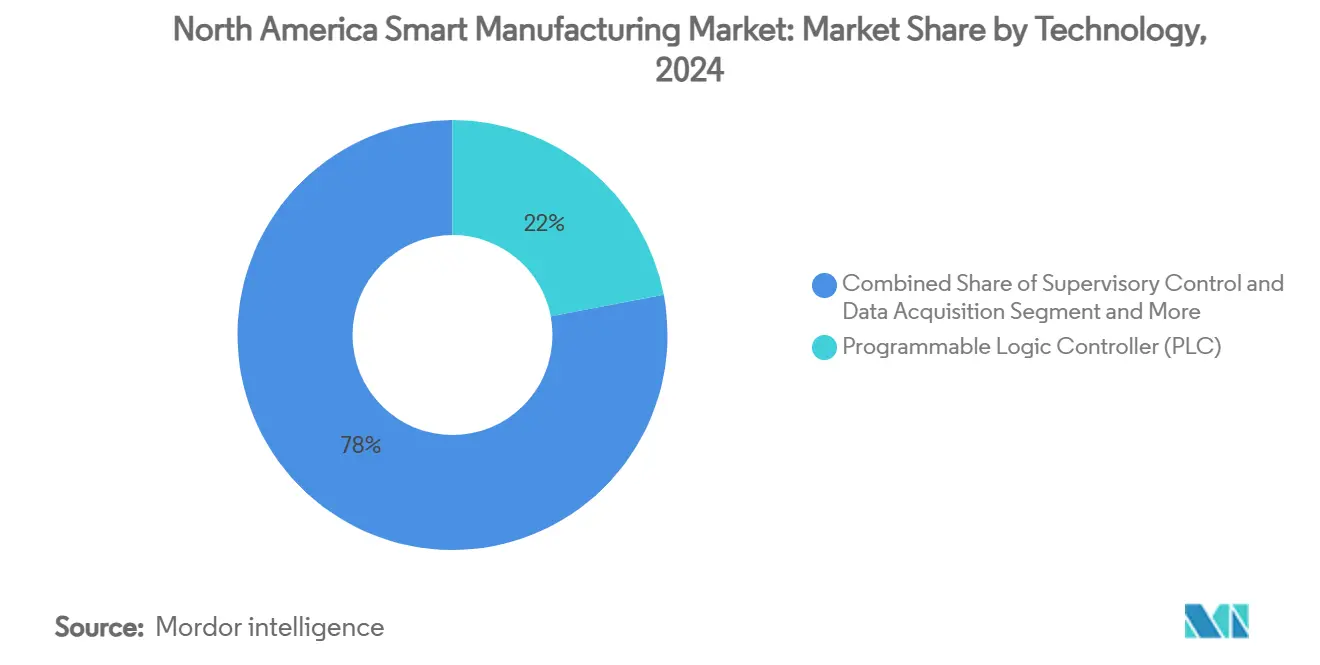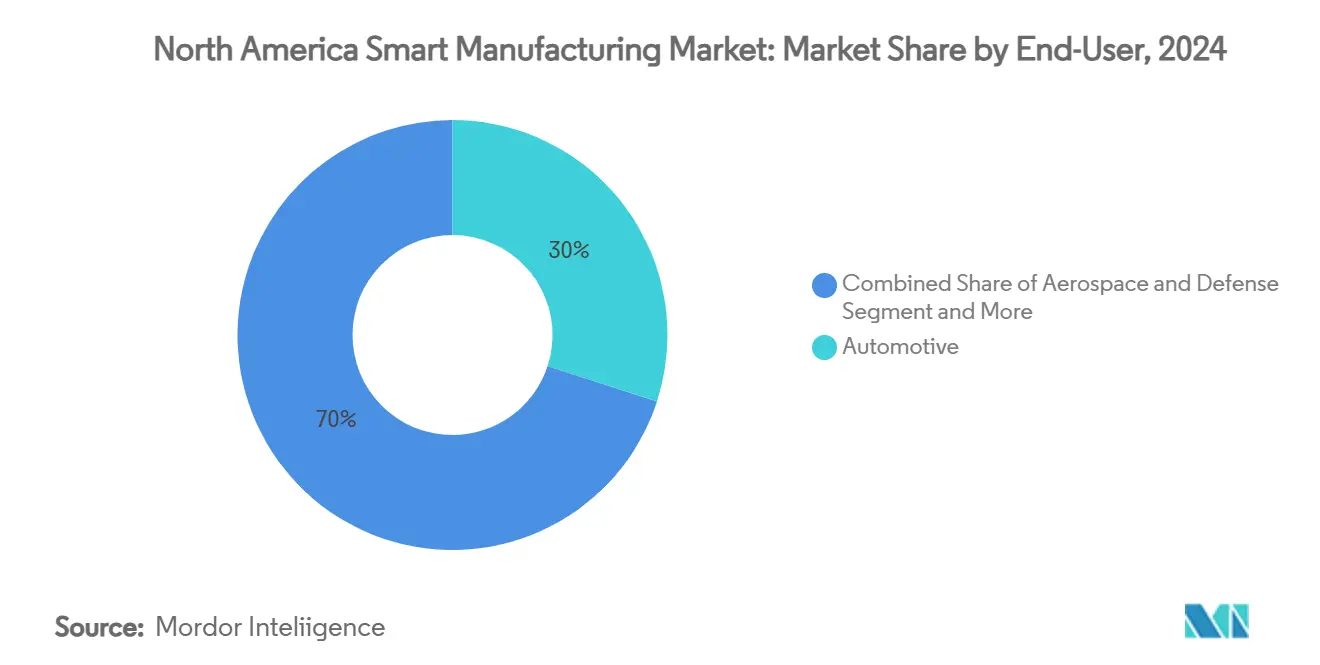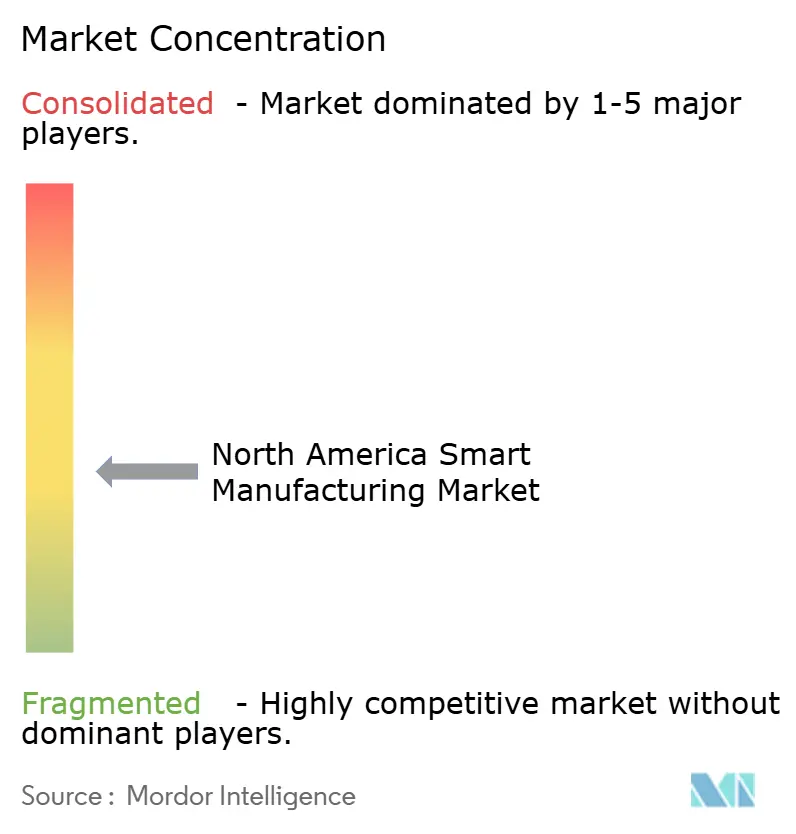
North America Smart Manufacturing Market Analysis by Mordor Intelligence
The North America smart manufacturing market reached USD 62.21 billion in 2025 and is forecast to attain USD 85.72 billion by 2030, advancing at a 6.62% CAGR. Momentum stems from record federal incentives, strong private-sector capital formation and the tight coupling of artificial intelligence, 5G and cyber-physical systems across discrete and process industries. More than 93% of manufacturers launched new AI initiatives in 2024, a signal that predictive, self-optimizing production environments are moving from pilots to scaled rollouts. Semiconductor reshoring, automotive electrification mandates and battery supply-chain buildouts anchor demand, while pharmaceutical and life-sciences facilities accelerate upgrades to meet stringent compliance requirements. The North America smart manufacturing market is also shaped by shifting workforce dynamics, with skilled-trades attrition and cyber-insurance cost spikes tempering adoption velocity among small and mid-sized enterprises.
Key Report Takeaways
- By technology, collaborative robotics is the fastest-growing segment at an 8.6% CAGR through 2030, while Programmable Logic Controllers led with 22% revenue share in 2024.
- By component, hardware retained 55% of the North America smart manufacturing market share in 2024, yet software and services are projected to rise at a 10% CAGR to 2030.
- By end-user industry, automotive held 30% revenue share in 2024; pharmaceutical and life sciences is forecast to expand at a 9.5% CAGR through 2030.
- By deployment, on-premise solutions commanded 61.2% of the North America smart manufacturing market size in 2024, whereas cloud deployments are set to grow at a 9.6% CAGR.
- By country, the United States contributed 81% revenue share in 2024, while Canada is expected to register a 9% CAGR to 2030
North America Smart Manufacturing Market Trends and Insights
Drivers Impact Analysis
| DRIVER | (~) % IMPACT ON CAGR FORECAST | GEOGRAPHIC RELEVANCE | IMPACT TIMELINE |
|---|---|---|---|
| Surging Adoption of AI-enabled Edge Analytics in U.S. Discrete Manufacturing | +1.8% | United States, with spillover to Canadian automotive clusters | Medium term (2-4 years) |
| Rapid Proliferation of 5G-powered Industrial IoT Networks across Canadian Plants | +1.2% | Canada-wide, with early gains in Ontario and Quebec manufacturing corridors | Short term (≤ 2 years) |
| Reshoring Incentives (CHIPS and Science Act, IRA) Fueling Digital-First Factories | +2.1% | United States, concentrated in semiconductor and battery manufacturing hubs | Long term (≥ 4 years) |
| Sustainability Mandates Driving Smart Energy-Management Retrofits in Brown-field Sites | +0.9% | North America, with stronger regulatory pressure in California and northeastern states | Medium term (2-4 years) |
| Adoption of Cyber-Physical Systems for Zero-Defect Production in Automotive Clusters | +1.1% | Michigan, Ontario, and southern U.S. automotive manufacturing regions | Medium term (2-4 years) |
| Growing Demand for Modular, Low-Code MES among SME Job-Shops | +0.7% | Distributed across North America, particularly in mid-market manufacturing regions | Short term (≤ 2 years) |
| Source: Mordor Intelligence | |||
Surging Adoption of AI-Enabled Edge Analytics in U.S. Discrete Manufacturing
AI algorithms are now embedded at the machine layer, enabling predictive maintenance that cuts unplanned downtime by up to 60% and extends asset lifespans by 20%. The Clean Energy Smart Manufacturing Innovation Institute broadens access to these tools through workforce programs, helping close data-science skill gaps.[1]Plant Services, “ABB and Microsoft Bring AI to Predictive Maintenance,” plantservices.com Manufacturers view on-site data processing as essential for latency-sensitive applications in automotive and aerospace where millisecond-level responses govern quality.
Rapid Proliferation of 5G-Powered Industrial IoT Networks across Canadian Plants
Private 5G networks eliminate historical connectivity bottlenecks; one U.S. steel facility recorded a 70-fold reduction in operational disruptions and annual savings of USD 2 million after adopting a 5G LAN solution. Manufacturing already accounts for 46% of announced private 5G deployments worldwide. The Canadian Wireless Telecommunications Association forecasts that 5G could cut national emissions by 12.2 MtCO₂e by 2025.[2]Celona, “Private 5G Transforms Steel Plant Operations,” celona.io
Reshoring Incentives Fueling Digital-First Factories
The CHIPS and Science Act and Inflation Reduction Act jointly unlocked more than USD 285 billion in manufacturing incentives, triggering USD 1 trillion in private-sector announcements since 2021. A new CHIPS Manufacturing USA Institute will apply digital twins to shrink semiconductor development cycles by 30%.[3]Manufacturing USA, “CHIPS Institute for Semiconductor Manufacturing,” manufacturingusa.com
Sustainability Mandates Driving Smart Energy-Management Retrofits
Schneider Electric’s Lexington factory leveraged Industrial IoT and analytics to cut energy use 26% and CO₂ emissions 30%, earning World Economic Forum Lighthouse status. Similar retrofits support corporate targets for carbon neutrality by 2040, positioning Manufacturing Execution Systems as compliance instruments.
Restraints Impact Analysis
| RESTRAINTS | (~) % IMPACT ON CAGR FORECAST | GEOGRAPHIC RELEVANCE | IMPACT TIMELINE |
|---|---|---|---|
| Persistent OT Cyber-Insurance Premium Hikes Limiting Digital Conversions | -1.4% | North America, with higher impact in critical infrastructure sectors | Short term (≤ 2 years) |
| Multi-vendor Interoperability Gaps in Legacy PLC Install-base | -1.1% | United States and Canada, particularly in brownfield manufacturing sites | Medium term (2-4 years) |
| Inflation-driven CAPEX Deferrals in Tier-2 Automotive Suppliers | -0.8% | Michigan, Ontario, and southern U.S. automotive supply chain clusters | Short term (≤ 2 years) |
| North American Skilled-Trades Attrition Outpacing Upskilling Pipelines | -1.6% | North America-wide, with acute shortages in technical manufacturing roles | Long term (≥ 4 years) |
| Source: Mordor Intelligence | |||
Persistent OT Cyber-Insurance Premium Hikes Limiting Digital Conversions
Ransomware incidents affected 65% of manufacturers in 2024, pushing premiums up more than 30% for firms introducing connected assets. Many plants still lack continuous OT monitoring, widening the gap between perceived and actual risk profiles.
North American Skilled-Trades Attrition Outpacing Upskilling Pipelines
Projections show 2.1 million manufacturing vacancies by 2030, threatening to dilute ROI on smart-factory investments. Annual openings for electricians, welders and automation technicians far exceed training throughput, intensifying wage inflation and project delays.
Segment Analysis
By Technology: AI-Driven Automation Reshapes Traditional Controls
Programmable Logic Controllers held 22% revenue in 2024, anchoring the control layer across thousands of plants. The North America smart manufacturing market size for collaborative robotics, however, is projected to rise at an 8.6% CAGR as manufacturers prioritize safe human-robot collaboration. Deployments such as OTTO Motors’ Autonomous Mobile Robots deliver 11-month paybacks and shrink work-cell footprints 15% without safety incidents.
Hybrid edge-to-cloud architectures increasingly unite PLCs with AI inference engines. Rockwell Automation and NVIDIA are co-developing reference designs that let operators apply generative AI for quality inspection flows. Machine vision now embeds neural networks for zero-defect assurance, while digital twins inside Product Lifecycle Management tools help test process tweaks virtually before physical execution.

Note: Segment shares of all individual segments available upon report purchase
By Component: Software Services Drive Digital Transformation
Control hardware accounted for 55% of 2024 spending, yet software and services are forecast to outpace at a 10% CAGR through 2030. Manufacturers increasingly embrace subscription models that bundle analytics, cybersecurity and continuous optimization, reducing time-to-value. Communication infrastructure—especially private 5G and Time-Sensitive Networking Ethernet—underpins this pivot and supports Industrial IoT scalability.
Advanced vision sensors spotlight the transition. Cognex’s In-Sight L38 3D system combines AI with dual-mode imaging to accelerate deployment by minimizing training data requirements. Robotics component kits, spanning SCARA to Autonomous Mobile Robots, further elevate flexibility, while MES 4.0 frameworks integrate IT and OT data lakes to slash inventory 30% and lift revenue per employee 75% in automotive trials.
By End-User Industry: Automotive Leadership Challenged by Pharma Growth
Automotive retained 30% of revenue in 2024, buoyed by electric vehicle platform ramps and digital stamping lines. Yet the pharmaceutical and life-sciences cohort is on track for a 9.5% CAGR, the fastest among all verticals. Bayer modernized its U.S. drug-substance plant with Siemens Opcenter Execution Pharma, achieving compliance upgrades without downtime.
Aerospace and defense maintain steady adoption as digital thread programs streamline aircraft assembly. Food and beverage plants deploy MES for end-to-end traceability, and electronics manufacturers catalyze capacity through CHIPS Act subsidies. Across these verticals the North America smart manufacturing market continues to diversify, mitigating over-reliance on a single sector.

Note: Segment shares of all individual segments available upon report purchase
By Deployment Mode: Cloud Adoption Accelerates Despite On-Premise Dominance
On-premise solutions secured 61.2% share in 2024, reflecting strict latency, IP and regulatory obligations. The cloud segment, though, is forecast to climb at a 9.6% CAGR. Pharmaceutical producers like Amgen run cloud-native analytics to support real-time process decisions, enhancing agility in biologics lines.
Hybrid architectures gain traction as firms use edge gateways for deterministic control while off-loading batch analytics to hyperscale platforms. Canada’s Digital Adoption Program sweetens economics by offering grants up to CAD 15,000 and interest-free loans up to CAD 100,000, spurring transformation among SMEs.
Geography Analysis
The United States accounted for 81% of the North America smart manufacturing market in 2024, a share driven by USD 285 billion in federal incentives that mobilized more than USD 1 trillion in private commitments. Seventeen manufacturing clusters concentrate resources in Illinois, Arizona, New York and other regions, pushing annual construction spending to USD 189 billion. Semiconductor hubs in Texas and Arizona, automotive electrification lines across Michigan and the Southeast and life-sciences corridors in the Northeast all generate robust incremental demand. Corporate announcements such as Texas Instruments’ USD 60 billion fab network and Schneider Electric’s USD 700 million upgrade program reinforce multiyear capacity pipelines.
Canada represented 19% of revenue yet is the fastest-growing geography at 9% CAGR through 2030. The Advanced Manufacturing Cluster channels CAD 427 million into automation, machine learning and cybersecurity to help SMEs adopt advanced technologies. Siemens' CAD 150 million Global AI Manufacturing Technologies Center places Canada at the forefront of battery innovation. Only 47% of Canadian manufacturers have a digital roadmap, so grant programs and zero-interest loans under the Digital Adoption Program stimulate pent-up demand.
Together, these dynamics forge a complementary regional ecosystem. U.S. scale and capital intensity pair with Canadian research depth and sustainability leadership. Cross-border supply chains in battery materials, semiconductors and electric vehicles benefit from harmonized policies that prioritize resilience and near-shoring, ensuring that the North America smart manufacturing market remains globally competitive through 2030.
Competitive Landscape
The North America smart manufacturing market features a moderate concentration where incumbent automation leaders coexist with cloud hyperscalers and AI-native newcomers. Siemens, Rockwell Automation, ABB and Schneider Electric leverage installed bases of PLCs, drives and MES platforms, yet each pivots toward as-a-service portfolios. Siemens collaborates with Microsoft and NVIDIA to co-develop industrial foundation models that embed generative AI into design, engineering and maintenance workflows.
Partnership ecosystems redefine competition. ABB and other vendors co-launched the Margo open-source initiative to improve Industrial IoT interoperability while ABB’s investment in Edgecom targets demand for AI-based energy optimization. OMRON lines up Cognizant as an engineering partner to merge IT and OT skill sets for automotive and life-sciences clients. These alliances blur boundaries among hardware, software and services and open lanes for niche specialists in cybersecurity, edge AI and private 5G orchestration.
Market fragmentation also benefits vertically focused players. Battery-specific MES suppliers, additive manufacturing workflow vendors and low-code industrial app developers secure footholds through domain expertise. Meanwhile insurers’ rising scrutiny of OT cyber-risk elevates demand for solution providers that bundle security, compliance and monitoring. Over the forecast horizon, vendor differentiation will hinge less on discrete product features and more on ecosystem integration, time-to-value and outcome-based pricing that aligns technology gains with measurable operational improvements.
North America Smart Manufacturing Industry Leaders
-
ABB Ltd
-
Emerson Electric Company
-
General Electric Company
-
Honeywell International Inc.
-
Rockwell Automation Inc.
- *Disclaimer: Major Players sorted in no particular order

Recent Industry Developments
- June 2025: Texas Instruments announced a USD 60 billion investment for seven semiconductor facilities in Texas and Utah, creating 60,000 jobs.
- May 2025: GE Vernova outlined nearly USD 600 million in new manufacturing investments across the United States.
- April 2025: OMRON and Cognizant entered a strategic partnership to integrate IT and OT across multiple industries.
- March 2025: Siemens confirmed a USD 10 billion U.S. expansion for software, AI and manufacturing capacity.
North America Smart Manufacturing Market Report Scope
Smart manufacturing uses computer-integrated manufacturing, high adaptability and quick design changes, digital information technology, and more adaptable technical workforce training, which includes fast changes in production levels based on demand, optimization of the supply chain, efficient production, and recyclability.
The scope of the market is limited to North America. The North American smart manufacturing market is segmented by technology, components, end-user industry, and geography (United States and Canada). The market sizes and forecasts are provided in terms of value (USD) for all the above segments.
| Supervisory Control and Data Acquisition (SCADA) |
| Distributed Control System (DCS) |
| Human-Machine Interface (HMI) |
| Manufacturing Execution System (MES) |
| Product Lifecycle Management (PLM) |
| Enterprise Resource Planning (ERP) |
| Robotics and Collaborative Robots |
| Machine Vision and Quality Inspection |
| Edge and Cloud Analytics Platforms |
| Control Devices (PLC, DCS, PAC) |
| Communication Infrastructure (5G, Industrial Ethernet) |
| Sensors and Actuators |
| Machine Vision Systems |
| Robotics (Articulated, SCARA, AMR) |
| Software and Services (MES, Digital Twin, SaaS) |
| Automotive |
| Aerospace and Defense |
| Oil and Gas (Upstream, Midstream, Downstream) |
| Chemicals and Petrochemicals |
| Pharmaceuticals and Life-Sciences |
| Food and Beverage |
| Metals and Mining |
| Electronics and Semiconductors |
| Pulp and Paper |
| Others (Textiles, Plastics) |
| On-premise |
| Cloud (SaaS) |
| Hybrid |
| United States |
| Canada |
| Mexico |
| By Techonology | Supervisory Control and Data Acquisition (SCADA) |
| Distributed Control System (DCS) | |
| Human-Machine Interface (HMI) | |
| Manufacturing Execution System (MES) | |
| Product Lifecycle Management (PLM) | |
| Enterprise Resource Planning (ERP) | |
| Robotics and Collaborative Robots | |
| Machine Vision and Quality Inspection | |
| Edge and Cloud Analytics Platforms | |
| By Component | Control Devices (PLC, DCS, PAC) |
| Communication Infrastructure (5G, Industrial Ethernet) | |
| Sensors and Actuators | |
| Machine Vision Systems | |
| Robotics (Articulated, SCARA, AMR) | |
| Software and Services (MES, Digital Twin, SaaS) | |
| By End-User Industry | Automotive |
| Aerospace and Defense | |
| Oil and Gas (Upstream, Midstream, Downstream) | |
| Chemicals and Petrochemicals | |
| Pharmaceuticals and Life-Sciences | |
| Food and Beverage | |
| Metals and Mining | |
| Electronics and Semiconductors | |
| Pulp and Paper | |
| Others (Textiles, Plastics) | |
| By Deployment Mode | On-premise |
| Cloud (SaaS) | |
| Hybrid | |
| By Country | United States |
| Canada | |
| Mexico |
Key Questions Answered in the Report
What is the current size of the North America smart manufacturing market?
The market reached USD 62.21 billion in 2025 and is projected to grow to USD 85.72 billion by 2030.
Which technology segment is expanding the fastest?
Collaborative robotics is forecast to post an 8.6% CAGR, reflecting demand for safe human-robot collaboration.
Why is cloud deployment gaining momentum in manufacturing?
Cloud platforms offer scalability and advanced analytics at lower upfront cost, driving a 9.6% CAGR while hybrid setups maintain data sovereignty.
How significant are U.S. government incentives for the industry?
Initiatives such as the CHIPS and Science Act and Inflation Reduction Act have mobilized more than USD 1 trillion in private manufacturing investments.
Which end-user industry will outpace others through 2030?
Pharmaceutical and life-sciences facilities are set to grow at a 9.5% CAGR, faster than any other vertical.
What are the primary obstacles to wider adoption among SMEs?
G cyber-insurance premiums, skilled-trades shortages and multi-vendor interoperability gaps hamper digital conversion efforts.
Page last updated on:



